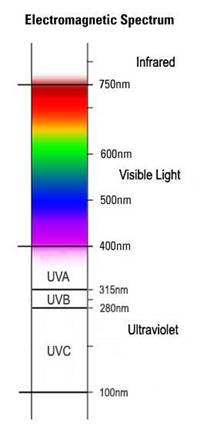


Similar term(s): UV radiation.
Electromagnetic radiation of shorter wavelength than visible light but of longer wavelenght than x-rays, i.e. ranging from approximately 400 nm to 100 nm.
The most common source of ultraviolet radiation is the sun, but it can also be produced artificially by UV lamps.
UV radiation is divided into three bands: UVA, UVB, and UVC. All three bands are classified as a probable human carcinogen.
UVA – Long-wavelength UVA covers the range 315–400 nm. Not significantly filtered by the atmosphere. Approximately 90% of UV radiation reaching the Earth’s surface. UVA is again divided into UVA-I (340 nm - 400 nm) and UVA-II (315 nm - 340 nm).
UVB – Medium-wavelength UVB covers the range 280–315 nm. Approximately 10% of UV radiation reaching the Earth’s surface.
UVC – Short-wavelength UVC covers the range 100–280 nm. All solar UVC radiation is absorbed by the ozone layer.
Source: GreenFacts based on WHO
![]()

Source: GreenFacts
Deutsch: UV-Strahlung
Español: Radiación ultravioleta
Français: Rayonnement ultraviolet